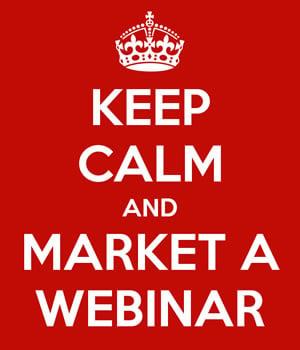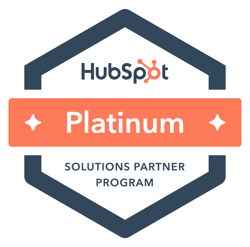Note: This post was updated and revised on February 2019.
So webinars have been kicking around for a while now - but there are still plenty of B2B companies who are not leveraging this kind of video content! Webinars eradicate the barriers of time and geography and make it easy for anyone to access your content anytime, anywhere.
So why isn't everyone doing it? If you get it right, webinars are a powerful, really cost-effective way of generating qualified and engaged leads - music to a marketer's ears right? What we're seeing is it's usually down to lack of resource, expertise or technology - but all of those can be easily fixed.
All in all, a webinar helps you to engage with your target market, nurture your leads and add value. To help you get started we've compiled 13 simple steps to successfully take your idea to reality and market your webinar effectively. 13 because it's a lucky number!
1. Define your audience
Before building a campaign to effectively market a webinar, you need to know who will benefit from attending. A large part of hosting a great webinar comes from bringing in active participants. Know who will be interested in the information presented and you have a solid starting point to building a marketing plan.
2. Get the timing right
Stick to 1 hour maximum for your session and ensure you schedule it at the most appropriate time for your audience not for you. Take into account time zones in North America, Europe and Asia.
3. Give your webinar the best chance of performing
Allow 6 weeks to execute your webinar marketing campaign. We have run numerous tests with long leadtimes and shorter ones and 6 weeks will ensure you gain the most amount of registrations to your webinar.
4. Put content first
The information presented during the webinar should be the primary draw for the event. Use teasers from the presentation as a large part of your marketing efforts. You can draw attention by having a recognised client run the session or participate as a panellist.
5. Maximise your email list
In general, emailing your own database of contacts gives you the best conversion rate (webinar sign ups) provided that you're clear about the value and benefits of attending the webinar and have a clear call to action.
6. Make regular contact with your audience
Send out several emails inviting your prospect attendees to the webinar. Avoid being repetitive, ensure your messages are varied (one focuses on the painpoints/challenges, another on the speakers etc) and by sending an email on a weekly basis this will drive extra registrants.
Another key finding is the importance of sending a final email within one day of your event, which can increase your registration by 37%. (Source: ON24 Benchmarking Report).
7. Do not rely on your email list only
Broaden your net, this is how you will get new prospects. So, consider leveraging third parties opt-in email lists; partnering with another company or thought leader that is happy to send invitations on your behalf; asking existing client suppliers to share it with their audience. The more people you send an invite to, the more people will attend your webinar. It's a numbers game.
8. Blog about the upcoming webinar
Your blog is a powerful tool for connecting with customers, so let your readers know about the webinar and convey your excitement. Give them an overview of the topics to be covered, speakers and participants, case studies and of course the link to register. This will also give you SEO wealth and an opportunity to update it later with the webinar recording.
9. Place an ad on your website
Not every customer or prospect reads your blog or takes the time to read all their emails, but a prominent banner on your website helps tremendously with your webinar marketing efforts. Shout about it.
10. Use your autosignatures
Regardless of how large or small your organisation is, get all your employees to put a link on their autosignatures to the webinar landing page. Do you know how many emails your organisation sends in one day? A nice quick and easy win.
11. Include social media channels
Blogging is a good start, but also add posts on Facebook, LinkedIn, Twitter and any other social media site you use to market your business. Fans, circles and other followers will see the upcoming event and you can garner additional attendance through these channels.
12. Direct all links to the webinar registration form
It might be tempting to try and cross-promote in your communications - check out our website, blog, latest news etc, to help boost traffic numbers, but you'll be diluting your primary purpose of marketing the webinar. Stick to directing everyone to the webinar landing page for further information, including one single link, the “Register” button and you will see a jump in your conversion numbers.
13. Send out reminders to your confirmed attendees with social sharing enabled
The average registration-to-attendance conversion rate varies between 42-60%, depending on the type of content, region, size of industry etc. (Source: ON24 Benchmarking Report)
No shows are normal for any webinar, but you can minimise this with well timed reminders. An email sent out immediately after they register, a day before the session and 1 hour before the session will minimise the drop outs. Don’t forget that “same-day” emails have a high conversion rate.
In addition, ensure all the registrant reminder emails include a call to action to share/forward to colleagues and social networks. Embed social media links on your emails and landing pages.
If you incorporate these 13 simple steps into your webinar marketing campaigns, you should see a solid registration and conversion rate - of course the content needs to be great quality and relevant to your audience!
We love integrating webinars into marketing campaigns for events and conferences and it's also a great way for consultants and technology providers to interact with their prospective audiences.
Reach out, follow up and keep things simple for your audience and your webinar is primed for success. Do you have any contributions of your own?







Do you have any comments?